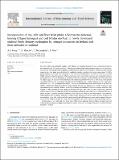| dc.contributor.author | Furey, A.E. | |
| dc.contributor.author | Hoeche, U. | |
| dc.contributor.author | McLaughlin, C. | |
| dc.contributor.author | Noci, F. | |
| dc.date.accessioned | 2022-09-20T11:20:40Z | |
| dc.date.available | 2022-09-20T11:20:40Z | |
| dc.date.copyright | 2022 | |
| dc.date.issued | 2022-04-07 | |
| dc.identifier.citation | A.E. Furey, U. Hoeche, C. McLaughlin, F. Noci, Incorporation of roe, milt and liver from plaice (Pleuronectes platessa), herring (Clupea harengus) and cod (Gadus morhua) in newly developed seafood Pâtés: Sensory evaluation by teenage consumers in Ireland and their attitudes to seafood, International Journal of Gastronomy and Food Science, Volume 28, 2022, 100524, ISSN 1878-450X, https://doi.org/10.1016/j.ijgfs.2022.100524. | en_US |
| dc.identifier.uri | http://research.thea.ie/handle/20.500.12065/4047 | |
| dc.description.abstract | Roe, milt and liver of marine fish caught in Irish fisheries are generally discarded at sea or processed on-shore as low-value fishmeal. This study aimed to 1) develop new added-value seafood products using roe, milt and liver; 2) determine eating quality and acceptance among teenagers; and 3) survey teenagers' attitudes towards seafood consumption. Four pâtés were developed by combining marine ingredients in varying proportions: 1) 100% plaice roe (RO), 2) 75% roe/25% milt (RM), 3) 75% roe/25% liver (RL) and 4) 75% roe/12.5% liver/12.5% milt (RLM) with plant-based ingredients. Physico-chemical, colour and texture analyses were conducted. Sensory evaluation using temporal dominance of sensations (TDS) and acceptance testing (hedonic and JAR scales) with 72 subjects aged 15–16 years were undertaken. Fat content ranged from 4% in RO to 15% in RL, while protein ranged from 21% to 17%, respectively. Significant L*a*b* differences (p < 0.05) resulted in a ‘great’ total colour difference (ΔE* = 11.56) between RO and RL. TDS curves indicated fish flavour and saltiness as the main attributes significantly dominating during oral processing. Flavour was important in overall acceptance, with perception of products being ‘too-fishy’ negatively impacting overall liking. Cumulative positive responses (‘like slightly’ to ‘like extremely’) for RO, RLM, RL and RM were 52%, 48%, 39% and 36%, respectively. Reported seafood consumption was relatively low (9% of respondents eating fish more than twice a week and 36% once a month or less). A positive correlation between overall liking and ‘desire to eat more seafood’ was observed. Approximately 33% of students stated they would consider snacking with the new pâtés. Positive acceptance of new products, along with positive attitude towards seafood and willingness to try new species suggests that roe, milt and liver could be incorporated into seafood formulations for healthy snacks in the Irish teenage market. Incorporation of roe, milt and liver from plaice (Pleuronectes platessa), herring (Clupea harengus) and cod (Gadus morhua) in newly developed seafood pâtés: sensory evaluation by teenage consumers in Ireland and their attitudes to seafood. | en_US |
| dc.format | application/pdf | en_US |
| dc.publisher | Elsevier B.V. | en_US |
| dc.relation.ispartof | International Journal of Gastronomy and Food Science | en_US |
| dc.rights | Attribution-NonCommercial-ShareAlike 4.0 International | * |
| dc.rights.uri | http://creativecommons.org/licenses/by-nc-sa/4.0/ | * |
| dc.subject | By-products | en_US |
| dc.subject | Fish | en_US |
| dc.subject | New product development | en_US |
| dc.subject | TDS | en_US |
| dc.title | Incorporation of roe, milt and liver from plaice (Pleuronectes platessa), herring (Clupea harengus) and cod (Gadus morhua) in newly developed seafood Pâtés: Sensory evaluation by teenage consumers in Ireland and their attitudes to seafood | en_US |
| dc.type | info:eu-repo/semantics/article | en_US |
| dc.contributor.affiliation | Letterkenny Institute of Technology, Letterkenny, F92 FC93, Ireland | en_US |
| dc.contributor.affiliation | Galway Mayo Institute of Technology, Galway, H91 T8NW, Ireland | en_US |
| dc.contributor.sponsor | The work was supported by Galway Mayo Institute of Technology (GMIT)/Connacht Ulster Alliance (CUA) PhD Completion Scholarship. | en_US |
| dc.description.peerreview | yes | en_US |
| dc.identifier.doi | 10.1016/j.ijgfs.2022.100524 | en_US |
| dc.identifier.orcid | 0000-0001-8967-5765 | en_US |
| dc.identifier.orcid | 0000-0003-0944-8074 | en_US |
| dc.identifier.url | https://www.sciencedirect.com/science/article/pii/S1878450X22000592 | en_US |
| dc.identifier.volume | 28 | en_US |
| dc.rights.accessrights | info:eu-repo/semantics/openAccess | en_US |
| dc.subject.department | Department of Sports Exercise & Nutrition | en_US |
| dc.type.version | info:eu-repo/semantics/publishedVersion | en_US |


